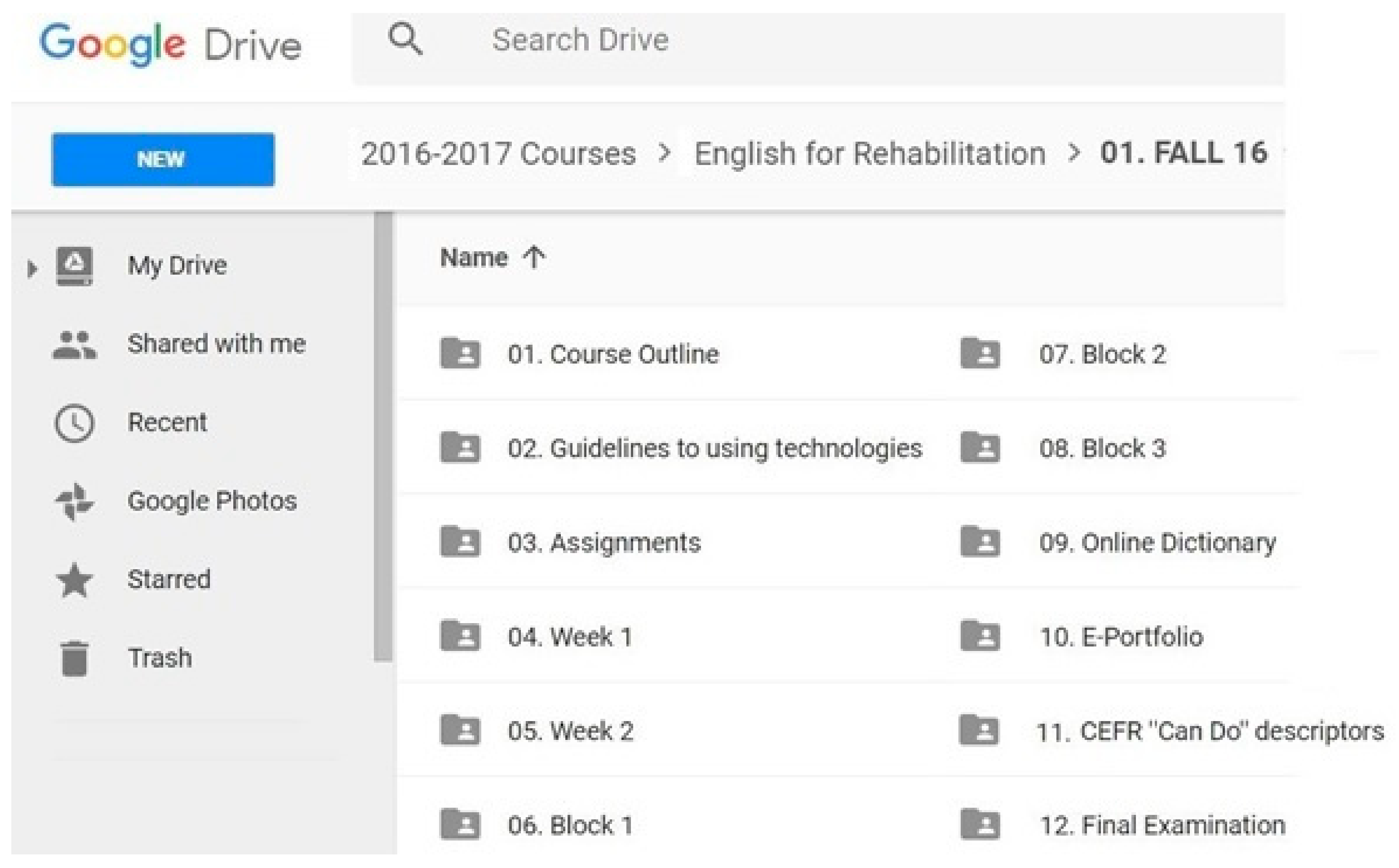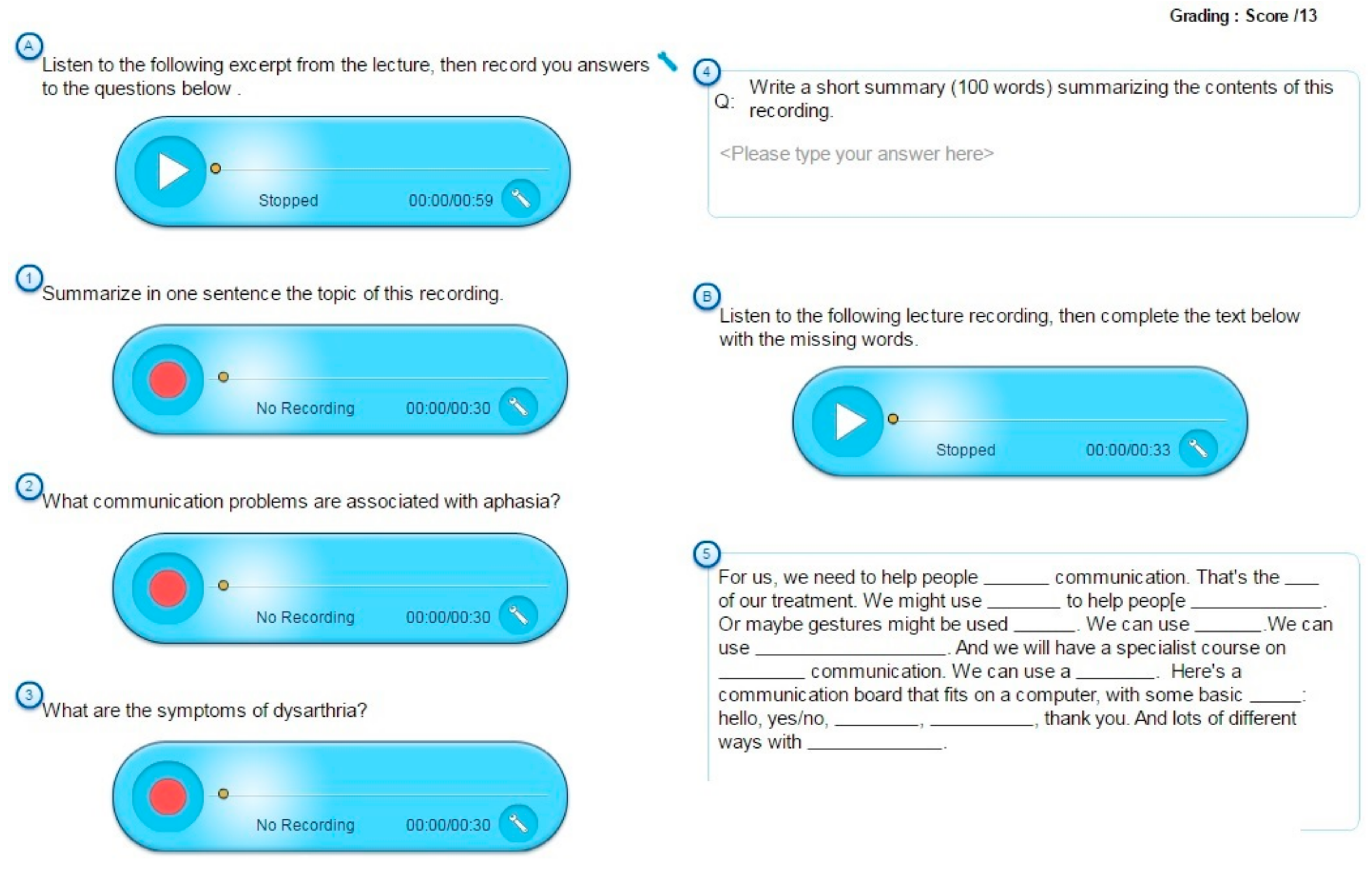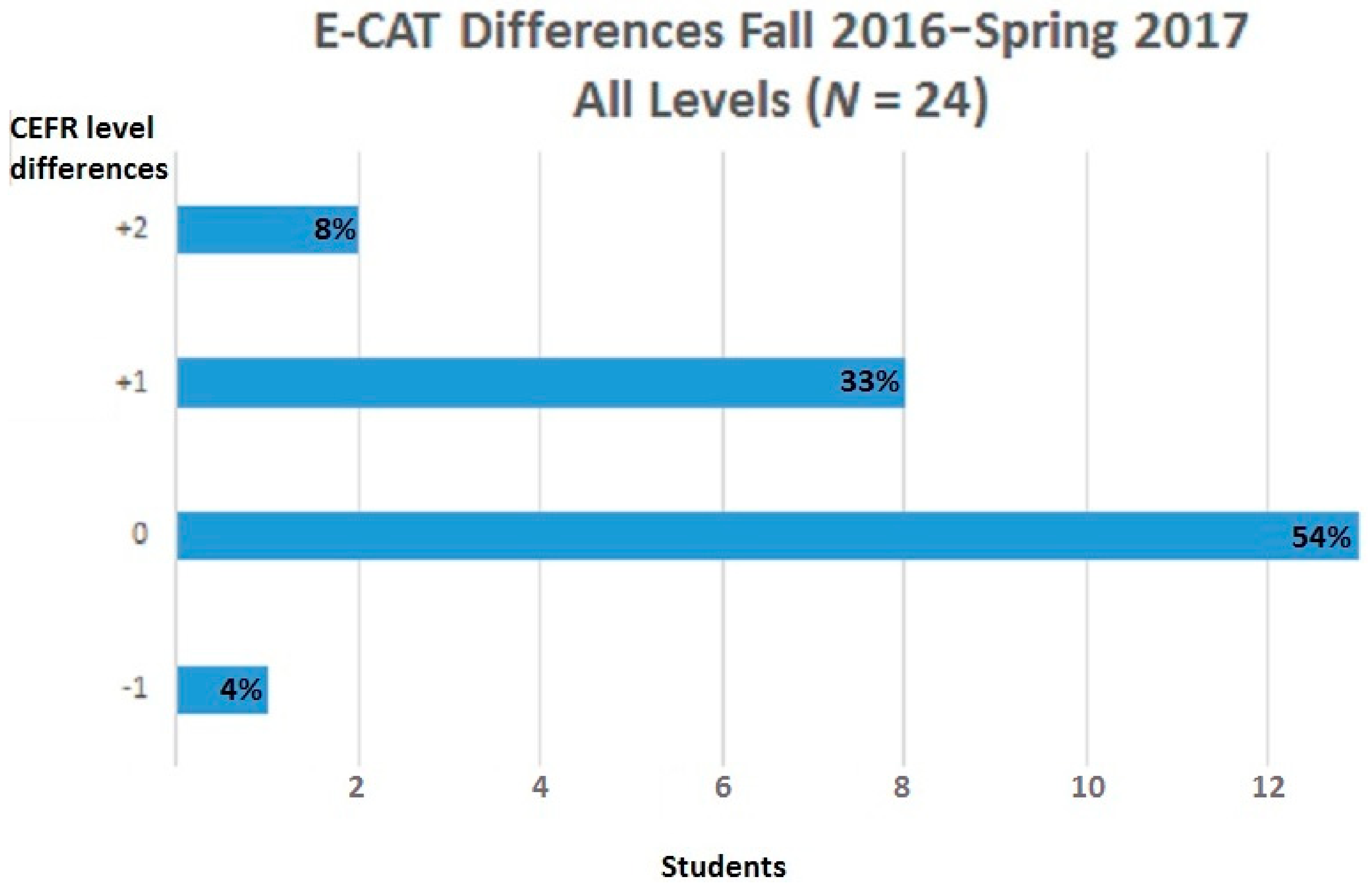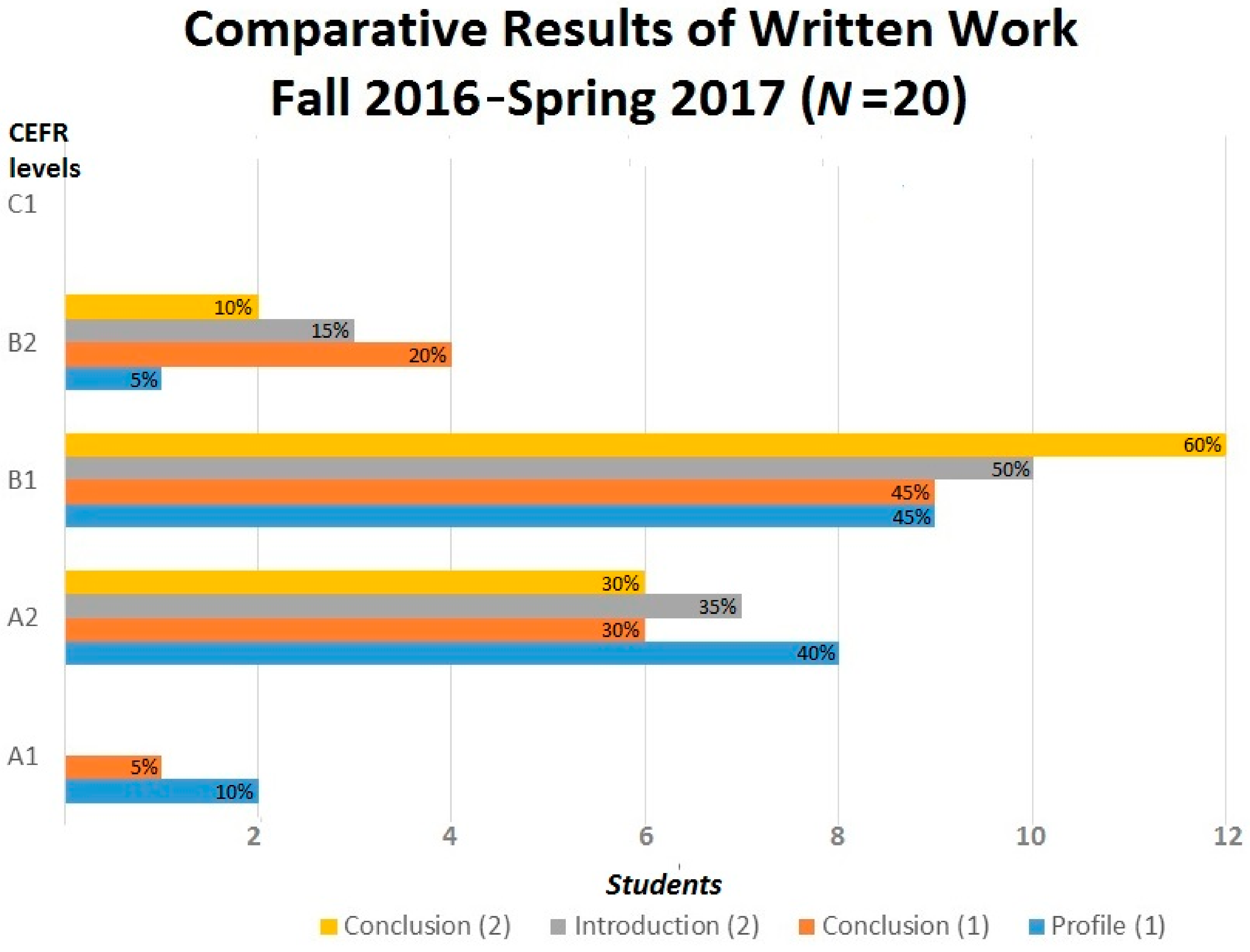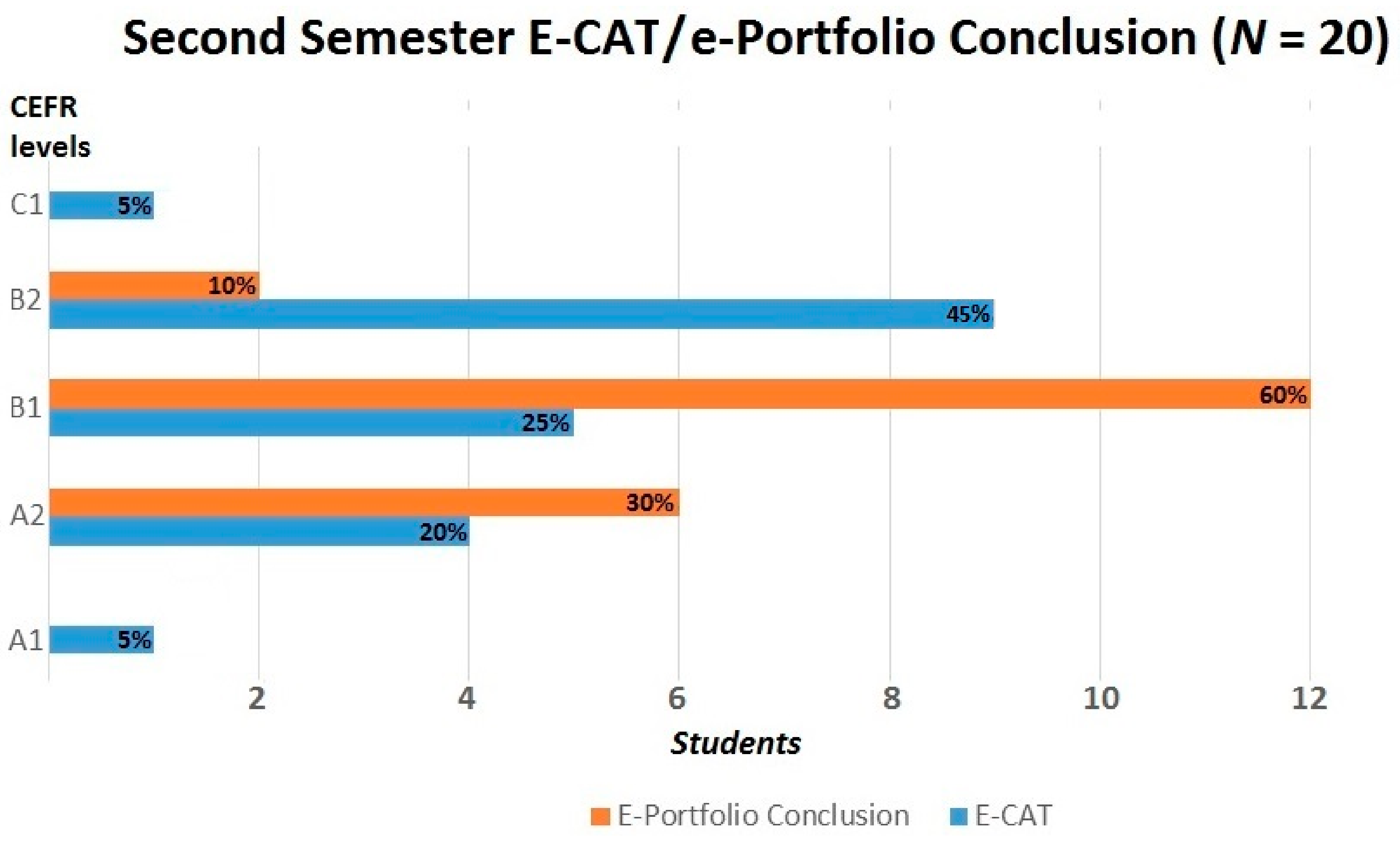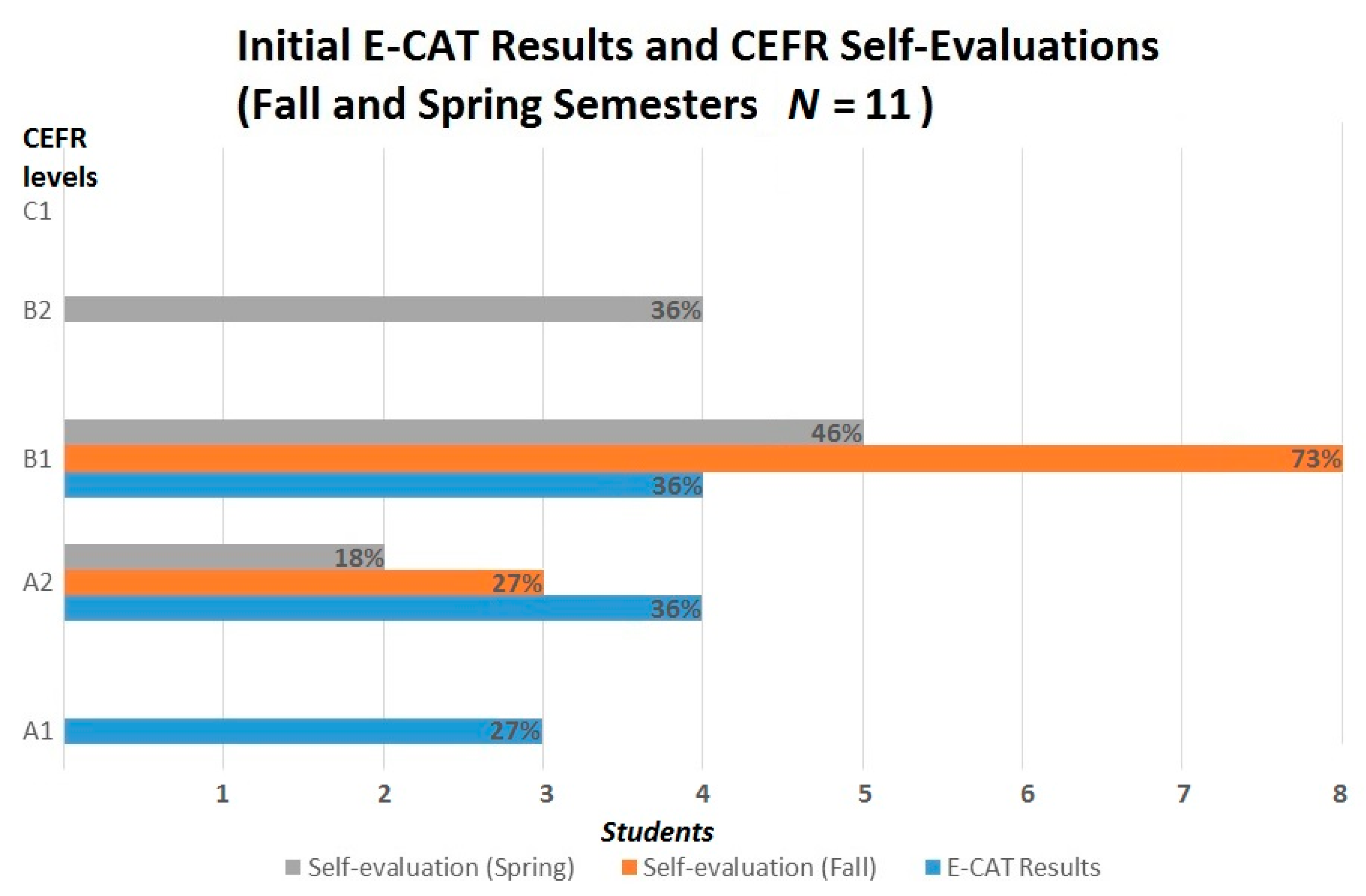1. Introduction
The presence of disparate competency levels of students in advanced-level language classes is a fact of life in all but the most highly selective programs. Even in well-endowed educational systems such as those in American universities, the range of foreign language competency among graduating language majors can be judged by the fact that nearly half (46%) score below Advanced-low according to the American Council on the Teaching of Foreign Languages scale in teacher certification exams [
1]. Moreover, median scores on competency level tests over the past 50 years in the US mask a pervasive inconsistency in foreign language competency that ranges “from abysmally poor to superior performance” [
2] (p. 134). Although serious and widespread, the problem goes almost completely unrecognized and only rarely have attempts been made to deal with it, as may be judged by the paucity of published research on the subject.
As in programs meant for foreign language majors, so, too, there is typically a broad range of linguistic competence in advanced-level Languages for Specific Purposes (LSP) courses, the students of which by definition major in non-language disciplines. This is very much the case in the English for Speech and Language Therapy course (ESLT) that is the subject of this study. In dealing with the challenge of addressing disparate foreign language competencies in this particular course, it is the intent of this study to propose a pedagogical model applicable to advanced-level LSP courses in general. The ESLT course borrows characteristics from two English for Academic Purposes (EAP) approaches, that of Genre/EAP and Academic Literacies [
3]. The first approach exploits writing models derived from specific disciplines [
4], while the latter focuses more generally on the social and ideological nature of academic writing independently of model texts [
4,
5]. However, these two approaches typically target a different student audience than the one in the course described here. The Genre/EAP approach is seen as applying to English as a Foreign Language (EFL) students primarily in university Language Centres whereas the Academic Literacies approach targets ”traditional” native speakers [
3,
5]. In comparison, students of the ESLT course are neither EFL nor native speakers of English. Moreover, the goals of this course are both academic and professional and therefore focus on all language skills, not just academic writing. Of the three models of collaboration between EAP instructors and subject lecturers proposed by Tribble and Wingate [
4], the ESLT course adopts the third type, in which EAP instructors and subject lecturers engage in team teaching. The course is also similar to that described by Wingate [
6], in that writing focuses as much on academic composition structure (evidence, evaluation, understanding, organization) as on strictly linguistic features. Drawing on the characteristics of these approaches and types of collaboration, the teaching of the ESLT course involves four complementary components: placement testing, curriculum design, metacognitive awareness raising, and ubiquitous instructional technology support. These are discussed in detail in what follows.
2. Placement Testing
Foreign language programs designed for specific academic purposes have an intrinsic interest in getting students to a level of competence that will allow them to function as independent language learners. This is especially so when the course is directly related to professional training, as is the case with the students majoring in Speech and Language Therapy, a Health Faculty discipline, at the Cyprus University of Technology (Cyprus). Their English for Specific Academic Purposes (ESAP) course is a compulsory two-semester first-year offering taught by the Language Centre. The students in this course are almost exclusively female and aged 18–19 years.
In the design of this course, learning objectives adhere to the Common European Framework of References for Languages (CEFR). According to the Council of Europe [
7] (p. 1), the CEFR “describes in a comprehensive way what language learners have to learn to do in order to use a language for communication and what knowledge and skills they have to develop so as to be able to act effectively”. The CEFR defines foreign language proficiency at three main levels: A (Basic User), B (Independent User), C (Proficient User). Each main level is further divided into an upper and lower sublevel: A1, A2, B1, B2, C1, C2 [
7] (p. 23). According to the CEFR, learners only begin to have sufficient competence to independently continue their acquisition of a foreign language from the B1 level. However, to fully reach independent learner status, they have to attain the B2 level.
It is the goal of the ESLT course that by the end of the second semester students should be able to function professionally in English as independent learners at the B2 level, in all four skills: reading, writing, speaking, listening. Yet the competence level of incoming students in this course is anything but homogeneous. Although all students entering the University have received at least nine years previous instruction in English and are expected to be at the B1 level, it was obvious from previous experience in the course that a large portion of incoming students did not meet this requirement. The aim of the ESAP course, therefore, is to build on existing competence to bring all students up to B2 independent learner status. The course overall includes 78 h of face-to-face instruction plus approximately another 100 h of independent study and assessment, thus approaching a total of 200 learning hours.
In order to identify students for whom the course would present the greatest challenge and to objectively determine the extent of the language competency gap that needed to be bridged, during the first week of class students took the English Computer-Adaptive Test (E-CAT) placement test, a Rasch model item response computer-adaptive test [
8] (
Figure 1). The E-CAT has been especially designed for first-year undergraduate students who attend the Language Centre’s ESAP courses. The items in the test were constructed by a group of Language Centre ESAP instructors with many years’ experience with CEFR descriptors. The instructors created the test items and then assigned these to a difficulty level, based on CEFR ”Can Do” parameters (see [
7]). Statistical analysis of some 1000 completed tests allowed the difficulty level of the test items to be determined with considerable accuracy, thereby confirming, or if need be adjusting, the CEFR level assignments. The accuracy of the E-CAT’s CEFR question level assignments is also currently being evaluated using the Cambridge English Profile (Vocabulary and Grammar) database (
htttp://www.englishprofile.org), the preliminary results of which largely confirm their validity [
9].
As can be seen, the placement test confirmed a range of competency levels from A2 to C2, with 21% (5/24) of the class below the B1 level. Students were immediately advised of their placement test results, with the weakest in effect put on notice that they would have to make a serious effort if they hoped to succeed in the course. This required the demonstration of at least a B1 level of competence by the end of the first semester and B2 by the end of the second semester.
3. The English for Specific Academic Purposes Course Design
3.1. Socio-Collaborative Interaction
The ESLT course embodies the principles of learning through socio-collaborative interaction, for instructors no less than students. Firstly, the course was realized in conjunction with faculty members of the Department of Rehabilitation Sciences. Its subject area content derives from an introductory course that is taught in the L1 (Greek) by disciplinary specialists and restructured by language teachers to focus on the interactive use of L2 English vocabulary and grammatical structures. Not only the design of the course, but also its implementation, has involved the ongoing contribution of academic faculty members. In consultation with colleagues from the Department of Rehabilitation Sciences, language instructors organized the course into seven thematic blocks, over the two semesters, each lasting three to four weeks. The first semester consists of three blocks, while the second semester of four blocks.
Each thematic block starts with a lecture by a member of the academic staff or an invited professional. The lecture relates to the block’s topic (e.g., Principles of Rehabilitation, Speech and Language Therapy, etc.); it lasts for 30–45 min and is delivered in English. Over the following weeks, students undertake various tasks based on the content theme. During each lecture, students take notes, which they then immediately discuss and compare in groups of 3–4, giving occasion for speaking and negotiation of meaning. For the second week of each block, working in small groups in and out of class, students practise their writing skills by producing a summary of the lecture, which provides further opportunities for linguistic interaction. During the remaining weeks of each block, students also focus on various ESAP skills: critical thinking, paraphrasing, argumentative writing, creating bibliographies, reading academic articles, searching for academic and other online material. This pattern is followed for all thematic blocks.
Twice each semester, students undertake out-of-class collaborative research projects based on video-clips of professionals working in the areas under study. They present these in a ten-minute oral summary in which each member of the group participates. In sum then, the tasks assigned within each thematic block provide multiple opportunities for students to develop their skills, both collaboratively and individually, in reading, writing, listening and speaking on topics directly deriving from the content of their professional course work. Finally, in the last week of each block, students provide their reflections on the content of the blocks and their learning.
At the end of each semester, for assessment purposes, students have to submit an individual electronic portfolio (e-portfolio) which requires them to synthesize all work (assessed and non-assessed) undertaken during the semester, including their course reflections. The e-portfolio is individually prepared and, in effect, constitutes each student’s self-generated textbook for the course. Assessment also includes a final exam, one for each semester, which, with the exception of oral production, involve the same ”Can Do” performance tasks undertaken in the course.
3.2. Common European Framework of References for Languages ”Can Do” Performance Tasks
All course activities are implemented and evaluated in terms of specific CEFR ”Can Do” descriptors, as illustrated in
Table 1 and
Table 2.
Throughout the course, the instructors made a list of the assignments and assessments and adapted these according to the CEFR descriptors [
7]. For example, at B1 level:
Listening as a member of a live audience [
7] (p. 67) (class lectures, discussions).
Note-taking [
7] (p. 96) (lectures, seminars).
Processing Text [
7] (p. 96) (individual lecture summaries).
Likewise, at B2 level:
Sustained Monologue [
7] (p. 59) (oral presentations on thematic block topic).
Goal-oriented co-operation [
7] (p. 79) (summary of the lecture in groups).
Addressing audiences [
7] (p. 60) (in-class discussions).
While the goal of the course is to bring all students up to the B1 level by the end of the first semester, with 21% of the incoming class below this level, ”Can Do” task criteria initially needed to be set at A2 to allow weaker students to follow. This level then gradually increased from block to block to B1 at the mid-point of the first semester and B2 at the mid-point of the second semester. Owing to the technical nature of the course content, vocabulary of necessity was at the B2 level from the beginning of the two-semester programme.
4. Meta-Cognitive Awareness Raising
It is one thing for a course curriculum to follow a graduated set of explicit performance criteria like that of the CEFR, but quite another for students to realize these objectives without clearly understanding what is expected of them. However much students may want (or need) to improve their linguistic proficiency, left to their own devices, they really have little, if any, basis for determining what they have to do in concrete terms to reach a specific competence level such as B1 or eventually B2. In order to help students make the transition to the level of an independent language learner, at each step of the way, they are informed of the specific CEFR ”Can Do” performance criteria they are expected to meet in completing their assignments. The guiding principle motivating this approach is that for students to become independent language learners, they need to become consciously aware of, and practise, what they actually have to be able to do to function at an advanced level of language competency.
At the beginning of each block, instructors explain the assigned tasks to students along with their corresponding CEFR descriptors. For example, at the beginning of the first semester, students received the following activity description and accompanying B1 level CEFR descriptors (see
Table 1 and
Table 2):
“You will have to create your Speech and Language Therapy student profile, to present yourself orally, and then to put it in writing”.
Instructors discussed and illustrated the CEFR descriptors in class beforehand and students were made aware that these would be explicitly applied when evaluating their submitted work (which may or may not be graded). To further foster metalinguistic consciousness raising, at the end of every two blocks, students were asked to self-evaluate their language competence in relation to CEFR descriptors from A2 to C1, which they did by checking the appropriate box in an online document.
5. Exploiting Ubiquitous Instructional Technology
Ubiquitously accessible instructional technology plays an essential role in supporting efforts to bring student language competence up to the expected performance levels of the ESLT course.
When thinking of anywhere-anytime access to language learning resources, the first thing that comes to mind is, of course, Mobile-Assisted Language Learning (MALL) and the corresponding use of handheld devices. However, as has long been recognized in MALL studies [
10], mobility has as much to do with the movement of the learner as with the use of handheld devices. So, too, even when mobile devices are available, research has shown that most students access MALL resources not on the go (e.g., on public transportation), but rather in quieter, calmer, places more conducive to learning, i.e., at home, in dorm rooms, or the library [
11,
12,
13,
14]. Moreover, as several studies have demonstrated [
15,
16,
17], given the option to access the same pedagogical materials via handheld devices or larger computers, adult learners consistently choose the latter. In the case of our students, the advanced nature of the linguistic tasks and level of concentration required to complete them (e.g., listening to lectures, reading professional literature, watching case study video clips, etc.) simply does not lend itself well to the on-the-go usage of mobile devices. Text input is also frequently required for note- taking, summarizing, paraphrasing and commenting, which is much better undertaken with a large screen and physical keyboard.
Our approach to raising the L2 English competence of our students to that of a fully independent learner thus relies critically upon the use of two cloud-based systems: Google+ (i.e., Google Drive, Google Docs (Google, Inc., Mountain View, CA, USA)) and Schoolshape (Schoolshape Limited, La Garenne, Le Catillon, Grouville, Jersey JE3 9UR) a digital language lab program.
1 Google+ and the student module of Schoolshape can be operated on handheld mobile devices, but what is of greater importance is the fact that students can access course resources on whatever tablet, laptop, or desktop computer happens to be at hand, anywhere there is a broadband Internet connection. Together, Google+ and Schoolshape provide the means to extend learning out of the classroom into the real world, to free it from time constraints, to store, access and share information for collaborative tasks and, most importantly, to scaffold pedagogical exercises.
Firstly, Google Drive (GDrive) allows all the course material to be stored in a central online location, conveniently organized into folders and sub-folders as required and accessible to instructors and students alike anywhere, anytime, from whatever device is most convenient (
Figure 2).
GDrive, used in conjunction with Google Docs (GDocs), also allows students to create, store and submit their own individual course work, and most importantly, their e-portfolio, which includes all the tasks and reflections set during the whole semester. GDrive also fosters collaborative work amongst students since it allows them to create, store, share and collectively edit documents without the need for physically coming together at some particular time or place. All additions and changes are tracked, so group members can see each other’s contributions and comment upon them as required. Because GDocs supports synchronous as well as asynchronous group editing, when working together in class on draft revisions, absent students could even log into the session and participate from wherever they happened to be.
The use of Schoolshape complemented that of Google+, giving students the opportunity to practise academic and English language usage on their own, thus greatly extending time on the task out of class. Schoolshape activities supported and reinforced the acquisition of disciplinary course content and technical vocabulary as well as listening comprehension, reading, writing and speaking skills. Lectures given by members of the academic staff and visiting professionals were audio recorded and then re-edited to extract passages, of one to two minutes’ duration, that lent themselves best to linguistic exploitation. These were used in conjunction with screen shots of accompanying PowerPoint (Microsoft Corporation, Redmond, WA, USA) presentations to provide visual support for listening comprehension exercises. Brief video clips and short readings from external sources relating to lecture topics were likewise used to supplement course content and language exposure. Using Schoolshape, these resources formed the basis of a considerable variety of activity types, i.e., multiple-choice, text gap-fill, labeled images, open-ended text responses, audio responses, audio gap-fill, and webcam video recording (
Figure 3). As with Google+ resources, these were accessible to students without the need for (or expense of) on-campus language labs or technical support infrastructure.
6. Preliminary Course Evaluation
The outcomes of the ESLT course were evaluated in terms of student performance as well as program effectiveness. This was done on the basis of a comparative analysis of three parameters. First, the E-CAT placement scores from the beginning of the first and end of the second semesters were compared. Although students took the same test, because of its adaptive nature, the actual question items varied on each administration thus making it unlikely that students would have seen many of the same items. Moreover, given the 32-week gap between the first and second administration of the test, students were not likely to have remembered any of the questions. Secondly, selected written assignments from the Fall and Spring semesters were analyzed. Lastly, student CEFR self-evaluation forms, completed at the end of each semester, were compared.
6.1. E-CAT Comparisons
A comparison of the results of the two administrations of the E-CAT test is shown in
Figure 4 below.
2Although student numbers are too small for reliable estimates of statistical significance, what is most noticeable is the decrease in the number of students at A2 level from five to one (21% to 4%) and an increase in the number of students at B1 level from six to eight (25% to 33%). The total number of students below B1 level thus decreased by 81%, while the number of students at B1 level increased by 32%. Moreover, there was an increase in the number of students at C1 level from five to seven (21% to 29%), an improvement of 38%. As can be seen in
Figure 5, all levels considered, only one student (4%) scored one CEFR sub-level lower at the end of the year, though this was from C2 to C1. Thirteen (54%) students received the same results compared to ten (41%) who scored higher, of which eight (33%) by one CEFR sub-level and two (8%) by two CEFR sub-levels.
6.2. Written Work Comparisons
The comparison of student writing was undertaken on the basis of four pieces of work, two from the first semester and two from the second semester. The first semester samples consisted of a student profile done at the beginning of classes and the conclusion statement of the e-portfolio submitted at the end of the first semester. The second semester samples consisted of the introduction and conclusion of the e-portfolio submitted at the end of the course. In their first semester 150–200 word profile, students introduced themselves and explained why they had chosen to major in Speech and Language Therapy at the Cyprus University of Technology. In the introduction of their second semester e-portfolio, they wrote a 150–200 word description of their e-portfolio contents. In the e-portfolio conclusions of both semesters, students wrote a 300-word summary about what they had done during the course and what they thought they had learned from it, from their own work, that of their group members, and the rest of the class. All four written assignments were assessed according to CEFR ”Can Do” criteria. Due to discontinuations between the first and second semesters and missing assignments, results are based on a total of 20 students.
The instructors in the course assessed the writing of their own students, then exchanged copies and evaluated their colleague’s students. In most cases, the evaluation was the same, but where discrepancies existed these did not exceed a CEFR sub-level. These were discussed and a consensus reached on the competence levels.
Overall, based on a comparison of the first and last writing assignments from the first semester (1), improvement in the students’ CEFR level in writing was modest (
Figure 6). Given the time period of 13 weeks, and the fact that the class met for only an hour and a half each week, such a result is nonetheless encouraging. As manifested in the student profiles of the 20 students who completed all four assignments, it can be seen (
Figure 6) that two (10%) were initially rated at a CEFR A1 level, eight (40%) were at A2 level, nine (45%) at B1 level and one (5%) at B2 level. In comparison, in the first semester e-portfolio conclusion, while the number of students at B1 level remained unchanged at 9 (45%), there was a noticeable increase from one to four (5% to 20%) at B2 level and a decrease from two to one (10% to 5%) at A1 level. The number also decreased at A2 level from eight to six (40% to 30%), resulting in an overall reduction in the number of students from 50% to 35% below B1 level. Regarding the Spring semester e-portfolio introduction, written at the end of the second semester (2), no students were placed at A1 level, while in comparison with the first semester portfolio conclusion the number of students increased from six to seven (from 30% to 35%) at A2 level. Moreover, the number of students at B1 level increased from nine to ten (45% to 50%) while at B2 level it decreased from four to three (20% to 15%). Finally, in the Spring semester e-portfolio conclusion, again no students were placed at A1 level. In comparison with the second semester portfolio introduction, the number of students at both A2 and B2 decreased by one, from seven to six (35% to 30%) in the former and from three to two (15% to 10%) in the latter. Most notably, 12 students (60%), the largest number, were placed at B1 level.
Lastly, in comparing the CEFR rankings of the 20 students who took both the E-CAT and submitted an e-portfolio conclusion in the second semester (
Figure 7), it can be seen that the overall distribution of CEFR levels in both cases manifests approximately the same bell shape, with a peak at B1 for the e-portfolio conclusion and B2 for the E-CAT. The number of students ranked below B1 level in both the e-portfolio conclusion and the E-CAT is more or less the same, reaching 30% and 25% respectively. As noted previously, the e-portfolio conclusions contain no students at A1 level. The most important difference, however, can be observed in the number of students who scored above B1 level. Specifically, nine students (45%) were rated at B2 and one (5%) at C1 in the second semester E-CAT, while only 2 (10%) were placed at B2 and none at C1 in the e-portfolio conclusion. Most likely, this was due to the fact that the E-CAT was a quantitative assessment measure, dealing primarily with receptive reading and listening comprehension, while the e-portfolio conclusion focused on productive writing, which is a different and more difficult skill to master.
6.3. CEFR Self-Evaluations
At the end of the Fall 2016 and Spring 2017 semesters, students were asked to self-evaluate the CEFR level at which they would rate themselves. To do this, they were given an online document, which included all CEFR descriptors and levels that described the activities of each block in each of the two semesters. Instructors distributed and explained these activities and the corresponding CEFR descriptors to the students at the beginning of each block, in order to raise their metacognitive awareness (see
Section 4). For the purposes of the present analysis, only the self-evaluations of students which the E-CAT initially placed below B2 were taken into consideration since this was the targeted output level of the two-semester sequence. For this reason, and because not all students completed the assignment, only eleven self-evaluations were examined. In order to analyse this data, each CEFR level was given points from one to five, with A1 = 1 and C1 = 5. For each general CEFR descriptor, the highest self-rating was noted, added to the other general descriptors and then divided by the overall number of descriptors. Depending on the average result, the students were then rated at the CEFR level according to the points assigned.
Figure 8 shows the initial E-CAT CEFR level of students and where they placed themselves at the end of the Fall Semester and again at the end of the Spring Semester.
As can be seen, three (27%) of the eleven students had an initial E-CAT rating of A1, and four (36%) were at A2 level and B1 level. No students rated themselves at A1 level in either of the two semesters because no descriptors were provided at that level, it being expected that they would already be at least at A2 level. In the Fall semester self-evaluation, three students (27%) placed themselves at A2 level and eight (73%) at B1 level, while no one rated themselves at a B2 level or above. As far as the Spring semester self-evaluation is concerned, four students (36%) indicated that they “can do” activities at the B2 level. Correspondingly, the number of students who rated themselves at A2 level fell to two (18%), while students at B1 level dropped to five (46%). On an individual basis, compared to the first semester, the self-evaluations of all students but one went up a CEFR sub-level. The exception, who was originally placed at A2 by the E-CAT, rated herself at B1 in the first semester and dropped back to A2 in the second semester self-evaluation. Overall, apart from the fact that this is a small sample, it can be said that the results are encouraging and that further improvements in the course may bring more improvement.
7. Conclusions and Consequences for Second Semester
The aim of the present study was to propose a pedagogical model that could be implemented in advanced-level LSP courses, mainly focusing on four elements: placement testing, curriculum design, metacognitive awareness raising, and ubiquitous instructional technology, the latter being used to centralize the storage and distribution course resources, support collaborative student communicative interaction, and extend the teaching and learning process beyond the classroom.
In comparing the two E-CAT test results, the most notable signs of improvement are the substantial reduction in the number of students at A1 and A2 levels and the corresponding increase in the proportion of students at or above B1 level. Though more modest, comparison of the students’ written production from the beginning of the first semester to the end of the second semester likewise reveals a reduction in the number of students below the B1 level by the end of the year. So, too, the relative distribution of CEFR ratings is very similar between the results of the second semester E-CAT and the e-portfolio conclusion, with the greatest number of students at B1 level. The E-CAT, however, did rank more students above the B1 level compared to the second semester e-portfolio conclusion, a result attributed to the greater demands of the productive writing task. As with the E-CAT and writing results, student self-evaluations of their CEFR level also increased from the beginning to the end of the course.
While it is not possible to pinpoint the extent to which each of the four components underlying the ESLT course contributed to the observed improvements in student competency levels, in combination the pedagogical and technological innovations introduced in the course are demonstrably having a positive effect. Most particularly, this can be seen in the effectiveness of the ubiquitous access to course resources, communicative interaction and tutorial support provided by the affordances of Google+ and Schoolshape.
8. Limitations of the Study
Although substantial improvements in the students’ language level have been observed in the ESLT course, this study has certain limitations. While the academic year-long time frame was sufficient for observing changes in language competency, the number of students involved was too small to allow the calculation of statistically significant differences. So, too, the L1 Greek language background of the students and the very specific technical and professional nature of the ESLT course may restrict the effectiveness of the pedagogical approach described here when applied to students of other native-language backgrounds and ESP courses with different content and non-professional orientation. Lastly, measuring student performance in terms of CEFR levels presupposes the reliability and validity of an external objective test like the E-CAT and the accuracy of the instructor evaluation of students’ written compositions. Colleagues using other evaluation metrics may not achieve the same results.

